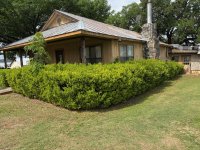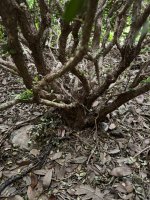UncleTrout
Sapling
Hey y'all,
I had posted this in the yamadori thread but wanted to make it's own for watching the progress on it and to maybe get a little more advice.
Quick recap - these boxwoods are by an old building where I work and the building is going to be torn down. It was originally due to start demo on 5/1 but nothing has started yet. With the demo, they are going to clear the lot (including the boxwoods) to see what the area could be used for in the future.
My main concern now is we are approaching summer and here in central Texas it gets very hot. I already have permission to collect them and am wondering if I should start to move and dig these up ASAP? I was waiting for the demo to start since there is a backhoe and other equipment I was hoping to utilize to make digging them up easier. However, I've read now that their root system isn't too deep and am thinking if I want to collect them I'd better get a shovel and get to digging. I just don't know how I'd approach the side against the house...
Follow up question so I am prepared when/if I dig them up - I've read about reducing foliage/canopy to match the rootball. I guess how much I'd trim back largely depends on how much root ball I get, but is there a general guideline to this? I'm also assuming after collecting, somewhere with morning sun and protected from afternoon heat would be ideal? They are about 4.5/5ft tall.. Been planted at this house for easily 20+ years..
I had posted this in the yamadori thread but wanted to make it's own for watching the progress on it and to maybe get a little more advice.
Quick recap - these boxwoods are by an old building where I work and the building is going to be torn down. It was originally due to start demo on 5/1 but nothing has started yet. With the demo, they are going to clear the lot (including the boxwoods) to see what the area could be used for in the future.
My main concern now is we are approaching summer and here in central Texas it gets very hot. I already have permission to collect them and am wondering if I should start to move and dig these up ASAP? I was waiting for the demo to start since there is a backhoe and other equipment I was hoping to utilize to make digging them up easier. However, I've read now that their root system isn't too deep and am thinking if I want to collect them I'd better get a shovel and get to digging. I just don't know how I'd approach the side against the house...
Follow up question so I am prepared when/if I dig them up - I've read about reducing foliage/canopy to match the rootball. I guess how much I'd trim back largely depends on how much root ball I get, but is there a general guideline to this? I'm also assuming after collecting, somewhere with morning sun and protected from afternoon heat would be ideal? They are about 4.5/5ft tall.. Been planted at this house for easily 20+ years..




